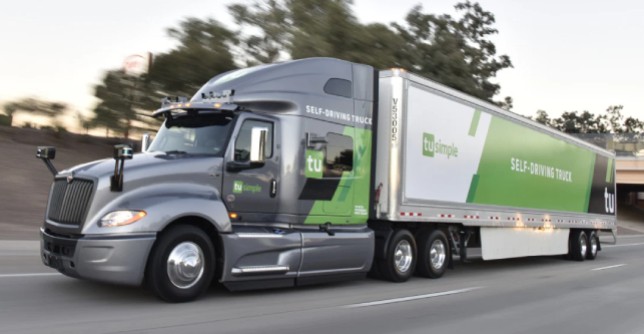Daimler Trucks announced it is establishing the Autonomous Technology Group as part of its effort to put highly automated trucks onto roadways within the next decade.
With automated trucks still five to 10 years away from commercial use, “it’s too soon to tell” what impact they will have on long-haul drivers, said Cindy Brown Barnes, a director of the U.S. Government Accountability Office’s (GAO) Education Workforce and Income Security team.
“The bottom line of this report is that automated trucking won’t impact the workforce immediately, so federal agencies have an opportunity to prepare drivers and others for possible workforce effects,” she said in an audio clip in GAO’s “WatchBlog” released Thursday, referencing the office’s March report to the Senate Transportation, Housing and Urban Development, and Related Agencies subcommittee.
The report concluded that automated and self-driving technology for commercial trucks would introduce “significant uncertainties” — such as the resulting effects on employment levels, wages and needed skills — for the trucking workforce that the departments of Labor and Transportation could help navigate.
The two agencies have coordinated stakeholder outreach as part of an analysis of the workforce impacts of automated trucking, according to the blog. Transportation also has gathered perspectives from members of the public to inform regulatory changes and Labor has incorporated technology changes into its employment projections for truck drivers, the blog states.
GAO in March made four recommendations to the departments.
“We recommended that the Department of Labor and Transportation continue to work together with stakeholders to analyze the workforce effects of these changes,” Barnes said. “We also recommended that the agencies work together to help inform transportation’s trucking regulations, like what skills a person needs to obtain a commercial driver’s license. We also recommended that labor consult with transportation to share information with key stakeholders as the technology evolves.”
She said there are two main future scenarios that would determine the role of truck drivers and operators. One scenario involves self-driving trucks being used on the highway portions of long-haul trips. Barnes said a local driver could transport goods to a drop-off area, where an automated truck would pick up the trailer and drive it the rest of the route.
“Under this scenario, there likely would be fewer long-haul drivers someday, but it could also reduce wages because there would be fewer jobs per truck, worker or truck driver,” she said.
Local-haul jobs could increase, however, and offset the long-haul losses, according to a study and several stakeholders, the office’s report states.
Self-driving trucks that still need operators to perform tasks, “such as fueling, changing tires, loading and unloading trucks,” is a second future scenario that would not have “as much of an effect on the number of people employed,” Barnes said.
“Many stakeholders believe automation could bring new trucking jobs, such as specialized technicians and mechanics, but these jobs may be located in different geographic areas, and require different skills, than the jobs lost,” according to the blog. “Areas with high concentrations of trucking jobs may be particularly affected by the adoption of automated technologies.”
Eastern New Mexico and Western Texas are two areas where the proportion of trucking jobs is higher than twice the national average, according to GAO analysis of the data from the May 2017 Occupational Employment Statistics. Any future job losses could first occur in the southwestern United States because several technology developers are focusing initial development of automated trucking technology in the region due to its good weather and long highways, the blog explains.
The U.S. Postal Service began testing self-driving trucks on a run of more than 1,000 miles between Phoenix and Dallas on May 21. The two-week pilot was to use trucks supplied by TuSimple to haul trailers on five roundtrips, according to The Wall Street Journal.
“This run is the sweet spot of where autonomy is valuable,” said Chuck Price, chief product officer at TuSimple, according to the article. “The vehicle can continue operating without the hours-of-service restrictions of a human driver.”
Daimler Trucks announced Wednesday it is establishing the Autonomous Technology Group as of Saturday to “comprise overall strategy and implementation of the automated driving roadmap … heading towards the series production of highly automated trucks (SAE level 4).”
Level 4 automation means “automation controls all aspects of driving in certain driving conditions and environments, such as on highways in good weather,” the GAO’s report states. “In these particular driving conditions and environments, a human driver would not be required to take over the driving task from the automated vehicle and the system would ensure the vehicle is functioning safely.”
The Autonomous Technology Group is part of Daimler Trucks’ effort to put highly automated trucks on roads within the decade. The German company, which agreed in March to acquire a majority stake in Torc Robotics, announced an investment of more than $570 million in highly automated trucks at the 2019 Consumer Electronics Show in Las Vegas.
“With the Autonomous Technology Group, we are bringing together our global experts and their vast knowledge in automated trucking,” said Peter Vaughn Schmidt, who is currently Daimler Trucks’ head of strategy and will head the Autonomous Technology Group, in a statement. “In the first stage, we will focus on use cases of highly automated driving in defined areas and between defined hubs in the USA. In doing so, we will work closely together with customers whose business matches this automated driving application. We will not only develop the respective technology but also set up the required operations infrastructure and network.”










